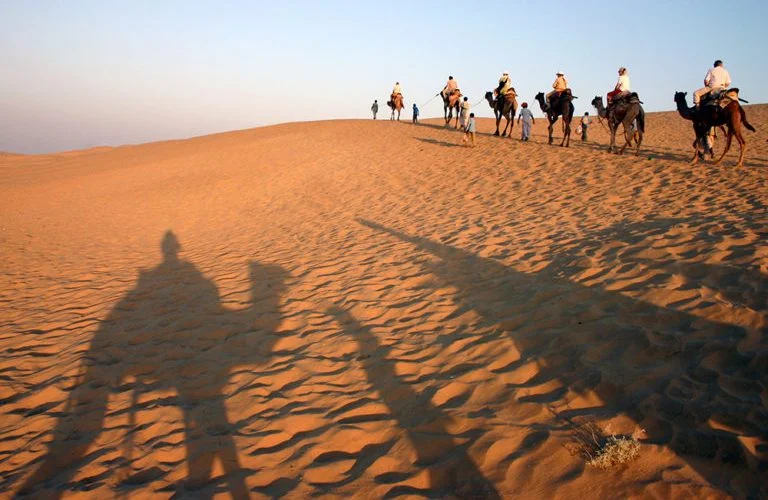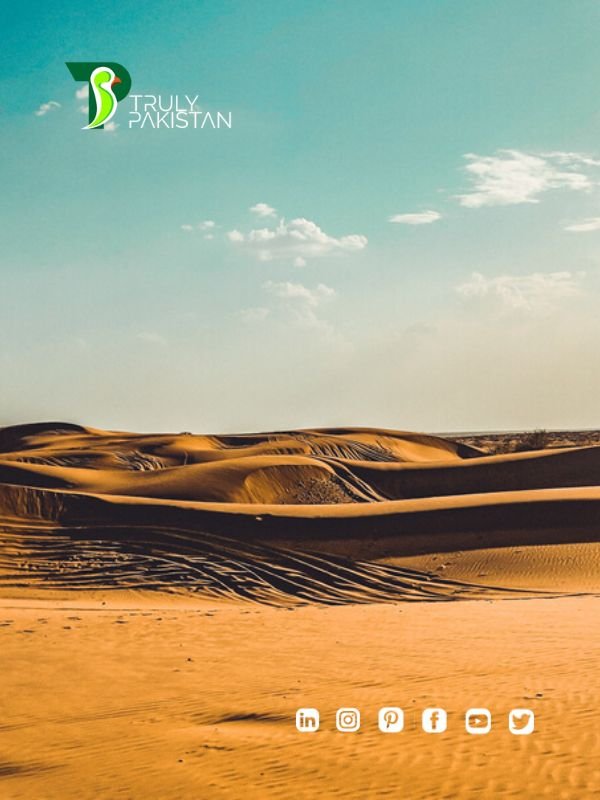Largest Desert of Pakistan: Complete Guide to Thar and Other Deserts


Quick Answer: The largest desert of Pakistan is the Thar Desert, stretching across an area of about 175,000–200,000 square kilometers. Roughly 15% of this vast desert lies in Pakistan’s Sindh and Punjab provinces, making it the country’s biggest desert system. Beyond its size, the Thar is also a hub of cultural life, unique ecosystems, and tourism potential.
In this guide, you’ll discover:
- Why Thar Desert is considered the largest desert of Pakistan
- How it compares with other deserts like Cholistan, Thal, and Katpana
- The cultural, ecological, and economic role of these deserts
- Future challenges and conservation efforts
Table of Contents
Which is the Largest Desert of Pakistan?
Thar Desert – Pakistan’s Largest Desert System
The Thar Desert, also known as the Great Indian Desert, extends across India and Pakistan. Within Pakistan, it spreads mainly through Sindh’s Tharparkar district and into parts of Punjab. Covering about 175,000–200,000 sq. km in total, it easily outscales other Pakistani deserts, making it the largest desert of Pakistan.
Geographic Boundaries and Area of Pakistan’s Largest Desert
Pakistan’s portion of the Thar spans approximately 30,000 sq. km. The desert is bordered by the Rann of Kutch to the south, the Indus River plains to the west, and Rajasthan to the east. These boundaries create a diverse ecosystem where shifting sand dunes meet scattered vegetation and small settlements.
Largest Desert of Pakistan vs Other Deserts in South Asia
Globally ranked among the top 20 deserts by area, the Thar is South Asia’s largest desert ecosystem. Unlike Cholistan, which covers just 25,800 sq. km, or Thal at 23,000 sq. km, the Thar dwarfs other regional deserts in both size and population density. Its cultural vibrancy, with thriving villages and festivals, makes it unique compared to more barren landscapes.


Complete List of Deserts in Pakistan
Pakistan’s Five Major Deserts Ranked by Size
Pakistan is home to five major deserts, each with unique geography and culture. Ranked by size, they are:
- Thar Desert – ~175,000–200,000 sq. km (Pakistan’s portion ~30,000 sq. km)
- Cholistan Desert – ~25,800 sq. km
- Thal Desert – ~23,000 sq. km
- Kharan Desert – ~20,000 sq. km
- Katpana Desert – ~2,600 sq. km (one of the highest cold deserts in the world)
Hot Deserts vs Cold Deserts in Pakistan
While most of Pakistan’s deserts are hot and arid, the Katpana Desert near Skardu is a rare cold desert. This distinction makes Pakistan geographically unique, housing both burning sand dunes in Sindh and icy desert plains in Gilgit-Baltistan.
Geographic Distribution of Pakistan’s Largest Desert Regions
Deserts in Pakistan are spread across four provinces:
- Sindh: Thar Desert
- Punjab: Cholistan and Thal Deserts
- Balochistan: Kharan Desert
- Gilgit-Baltistan: Katpana Cold Desert
This distribution shows how diverse Pakistan’s landscapes are, from scorching sand plains to freezing mountain deserts.
Thar Desert – Pakistan’s Largest Desert in Detail
Location and Extent of Thar Desert
The Thar Desert in Pakistan lies primarily in Sindh’s Tharparkar district, stretching east into Rajasthan, India. It is the only desert in Pakistan with a significant settled population, where villages and towns coexist with arid land.
Climate and Environment of the Largest Desert of Pakistan
The climate of Thar is typically harsh, with summer temperatures soaring above 45°C and scarce rainfall averaging 100–500 mm annually. Despite this, seasonal monsoons bring life to the region, temporarily transforming parts of the desert into green landscapes.
Flora, Fauna, and Biodiversity in Thar Desert
Thar supports a surprising variety of life:
- Flora: Xerophytic plants, shrubs, and grasses adapted to arid soil
- Fauna: Chinkara (gazelle), desert fox, peacocks, and migratory birds
- Human Activity: Nomadic pastoralism, livestock rearing, and small-scale agriculture
This biodiversity makes Thar not just the largest desert of Pakistan but also the most vibrant desert ecosystem in South Asia.
Cholistan Desert vs Thar Desert Size Comparison
Cholistan Desert Area and Boundaries
The Cholistan Desert, also known as Rohi, lies in southern Punjab near Bahawalpur. It covers an estimated 25,800 sq. km. The desert borders the Thar in the east and extends towards the Sutlej River in the north. Its famous Derawar Fort stands as a cultural landmark amid shifting dunes.
Largest Desert of Pakistan vs Cholistan Desert Facts
While Cholistan is vast, it is significantly smaller than the largest desert of Pakistan – Thar Desert. Thar’s Pakistan portion alone is bigger than Cholistan, and globally the Thar ranks among the world’s top 20 deserts. Cholistan is better known for nomadic camel caravans, cattle grazing, and the annual Cholistan Jeep Rally.
Tourism and Economic Role of Cholistan Desert
Cholistan’s economy is shaped by livestock rearing, camel breeding, and handicrafts such as embroidery. It is also a growing tourism hub, drawing visitors for desert safaris, cultural festivals, and heritage exploration.
Other Major Deserts in Pakistan
Thal Desert Features and Importance


The Thal Desert lies between the Indus and Jhelum rivers in Punjab, covering nearly 23,000 sq. km. Though smaller than Thar and Cholistan, it is vital for agriculture, with canal irrigation projects supporting crops like wheat and gram.
Kharan Desert Geography


Located in Balochistan, the Kharan Desert is an arid zone spanning about 20,000 sq. km. Known for its barren landscape, it gained historical significance when Pakistan conducted nuclear tests nearby in 1998.
Katpana Desert – Pakistan’s Cold Desert


The Katpana Desert, near Skardu in Gilgit-Baltistan, is one of the highest cold deserts in the world. At altitudes above 2,200 meters, it presents a unique icy landscape where snow and sand meet. Despite its small size (around 2,600 sq. km), it is a rare geographical phenomenon and a key attraction for northern tourism.
FAQ – Largest Desert of Pakistan
Which is the largest desert in Pakistan and its area?
The largest desert of Pakistan is the Thar Desert, covering 175,000–200,000 sq. km in total. Around 30,000 sq. km lies in Pakistan.
Where is the Thar Desert located in Pakistan?
The Thar Desert is mainly in Sindh’s Tharparkar district and parts of eastern Punjab, bordering Rajasthan in India.
How many deserts are there in Pakistan?
Pakistan has five major deserts: Thar, Cholistan, Thal, Kharan, and Katpana.
Is Cholistan bigger than Thar Desert?
No. Cholistan covers about 25,800 sq. km, while Thar is far larger, making it the largest desert of Pakistan.
What is the climate of Pakistan’s largest desert?
The Thar Desert has a hot, arid climate with summer temperatures exceeding 45°C and annual rainfall averaging 100–500 mm.
Which is the cold desert of Pakistan?
The Katpana Desert in Gilgit-Baltistan is Pakistan’s cold desert, famous for its snow-covered sand dunes.
What is the population of Thar Desert region?
Approximately 1.65 million people live in Pakistan’s portion of the Thar Desert, with livelihoods tied to livestock, farming, and handicrafts.
Why is Thar Desert important for Pakistan’s economy?
Thar contributes through livestock, traditional crafts, and coal reserves. It also holds growing potential for eco-tourism and cultural tourism.
Cultural and Economic Importance of Pakistan’s Largest Desert
Population and Communities of Thar Desert
The largest desert of Pakistan is not empty—it is home to vibrant communities. Nearly 1.65 million people live in Tharparkar, Sindh, where desert villages sustain themselves through livestock, handicrafts, and small-scale agriculture. Cultural festivals, folk music, and traditional embroidery form an integral part of desert life.
Tourism in the Largest Desert of Pakistan
The Thar Desert is increasingly promoted as a tourism destination. Activities include jeep safaris, camel rides, and exploring heritage sites like Nagarparkar temples. Visitors are also drawn to the annual Thar Desert Festival, which showcases local music, dance, and cuisine.
Natural Resources and Economic Activities
Thar is rich in natural resources, particularly coal reserves that have been tapped for power generation. Alongside mining, traditional crafts and livestock herding remain crucial for the local economy. The desert’s mixed economy highlights both opportunities and sustainability challenges.
Conservation and Future of Pakistan’s Largest Desert Systems
Environmental Challenges Facing Pakistan’s Largest Desert
Like many arid regions, the Thar Desert faces desertification, water scarcity, and biodiversity loss. Overgrazing and unsustainable mining also threaten its fragile ecosystem.
Conservation Efforts and UNESCO Projects
Pakistan has initiated programs in collaboration with UNESCO to protect biodiversity hotspots near desert zones. Local NGOs also run tree plantation drives and water management projects aimed at balancing economic growth with ecological preservation.
Climate Change Impact on Pakistan’s Desert Regions
Rising temperatures and unpredictable rainfall are expanding desert boundaries. The Thar Desert, already the largest desert of Pakistan, may grow in scale unless urgent measures are taken. Climate-smart agriculture and sustainable tourism are critical for the region’s survival.
Conclusion: Key Takeaways on the Largest Desert of Pakistan
The Thar Desert stands as the largest desert of Pakistan, covering around 175,000–200,000 sq. km and shaping the lives of millions. More than just a geographic feature, it is a cultural and economic heartland. Yet, it faces mounting environmental challenges that require urgent attention. By promoting sustainable tourism, conservation, and community empowerment, Pakistan can preserve the desert’s heritage for future generations.


Author: ZunNurain Khalid — Travel & Tourism Specialist, Founder of ExploreX Pvt. Ltd., and advocate for sustainable tourism in Pakistan. With over a decade of experience in digital marketing and destination branding, ZunNurain has worked extensively on promoting Pakistan’s natural and cultural heritage.


2 thoughts on “Largest Desert of Pakistan: Thar & Other Deserts Explained”